1944 United States presidential election
| |||||||||||||||||||||||||||||
531 electoral votes of the Electoral College 266 electoral votes needed to win | |||||||||||||||||||||||||||||
|---|---|---|---|---|---|---|---|---|---|---|---|---|---|---|---|---|---|---|---|---|---|---|---|---|---|---|---|---|---|
| Turnout | 55.9%[1] | ||||||||||||||||||||||||||||
| |||||||||||||||||||||||||||||
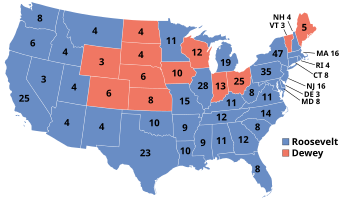  Presidential election results map. Blue denotes those won by Roosevelt/Truman, red denotes states won by Dewey/Bricker. Numbers indicate the number of electoral votes allotted to each state. | |||||||||||||||||||||||||||||
| |||||||||||||||||||||||||||||
The United States presidential election of 1944 was the 40th quadrennial presidential election, held on Tuesday, November 7, 1944. The election took place during World War II. Incumbent Democratic President Franklin D. Roosevelt defeated Republican Thomas E. Dewey.
Roosevelt had become the first president to win a third term with his victory in the 1940 presidential election, and there was little doubt that he would seek a fourth term. Unlike in 1940, Roosevelt faced little opposition within his own party, and he easily won the presidential nomination of the 1944 Democratic National Convention. However, that convention dropped Vice President Henry A. Wallace as Roosevelt's running mate in favor of Senator Harry S. Truman of Missouri. Governor Dewey of New York emerged as the front-runner for the Republican nomination after his victory in the Wisconsin primary, and he defeated conservative Governor John W. Bricker at the 1944 Republican National Convention.
As World War II was going well for the United States and its Allies, Roosevelt remained popular despite his long tenure. Dewey campaigned against the New Deal and for a smaller government, but was ultimately unsuccessful in convincing the country to change course. The election was closer than Roosevelt's other presidential campaigns, but Roosevelt still won by a comfortable margin in the popular vote and by a wide margin in the Electoral College. Rumors of Roosevelt's ill health, though somewhat dispelled by his vigorous campaigning, proved to be prescient; Roosevelt died less than three months into his fourth term and was succeeded by Truman.
Contents
1 Nominations
1.1 Democratic Party nomination
1.2 Republican Party
2 General election
2.1 The fall campaign
2.2 Results
2.3 Geography of results
2.3.1 Gallery of maps
2.3.2 Results by state
2.3.3 Close states
3 Miscellanea
4 See also
5 References
6 Further reading
7 External links
Nominations
Democratic Party nomination
Democratic Party Ticket, 1944 | |||||||||||||||||||||||||||||
Franklin D. Roosevelt | Harry S. Truman | ||||||||||||||||||||||||||||
|---|---|---|---|---|---|---|---|---|---|---|---|---|---|---|---|---|---|---|---|---|---|---|---|---|---|---|---|---|---|
for President | for Vice President | ||||||||||||||||||||||||||||
 |  | ||||||||||||||||||||||||||||
32nd President of the United States (1933–1945) | U.S. Senator from Missouri (1935–1945) | ||||||||||||||||||||||||||||
Campaign | |||||||||||||||||||||||||||||

Roosevelt/Truman poster
President Roosevelt was the popular, wartime incumbent and faced little formal opposition. Although many Southern Democrats mistrusted Roosevelt's racial policies, he brought enormous war activities to the region and the end of its marginal status was in sight. No major figure opposed Roosevelt publicly, and he was re-nominated easily when the Democratic Convention met in Chicago. Some pro-segregationist delegates tried to unite behind Virginia senator Harry F. Byrd, but he refused to campaign actively against Roosevelt, and did not get enough delegates to seriously threaten the President's chances.
The obvious physical decline in the president's appearance, as well as rumors of secret health problems, led many delegates and party leaders to strongly oppose Vice President Henry A. Wallace for a second term. Opposition to Wallace came especially from Catholic leaders in big cities and labor unions. Wallace, who had been Roosevelt's vice president since January 1941, was regarded by most conservatives as being too left-wing and personally eccentric to be next in line for the presidency. He had performed so poorly as economic coordinator that Roosevelt had to remove him from that post. Numerous party leaders privately sent word to Roosevelt that they would fight Wallace's re-nomination as vice president and proposed instead Senator Harry S. Truman, a moderate from Missouri. Truman was highly visible as the chairman of a Senate wartime committee investigating fraud and inefficiency in the war program. Roosevelt, who personally liked Wallace and knew little about Truman, reluctantly agreed to accept Truman as his running mate to preserve party unity.[2] Even so, many delegates on the left refused to abandon Wallace, and they cast their votes for him on the first ballot. However, enough large Northern, Midwestern, and Southern states supported Truman to give him victory on the second ballot. The fight over the vice presidential nomination proved to be consequential; Roosevelt died in April 1945, and Truman instead of Wallace became the nation's thirty-third President.[3]
Republican Party
Republican Party Ticket, 1944 | |||||||||||||||||||||||||||||
Thomas E. Dewey | John W. Bricker | ||||||||||||||||||||||||||||
|---|---|---|---|---|---|---|---|---|---|---|---|---|---|---|---|---|---|---|---|---|---|---|---|---|---|---|---|---|---|
for President | for Vice President | ||||||||||||||||||||||||||||
 |  | ||||||||||||||||||||||||||||
47th Governor of New York (1943–1954) | 54th Governor of Ohio (1939–1945) | ||||||||||||||||||||||||||||
Campaign | |||||||||||||||||||||||||||||
Republican candidates:

Governor Thomas E. Dewey of New York
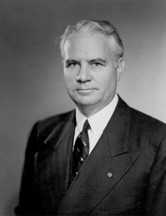
Governor John W. Bricker of Ohio
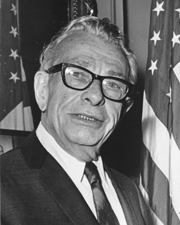
Representative Everett Dirksen from Illinois

General Douglas MacArthur from New York

Former Governor Harold Stassen of Minnesota

Businessman Wendell Willkie from New York
As 1944 began, the frontrunners for the Republican nomination appeared to be Wendell Willkie, the party's 1940 nominee, Senator Robert A. Taft from Ohio, the leader of the party's conservatives, New York Governor Thomas E. Dewey, the leader of the party's moderate eastern establishment, General Douglas MacArthur, then serving as an Allied commander in the Pacific theater of the war, and former Minnesota Governor Harold Stassen, then serving as a U.S. naval officer in the Pacific. Taft surprised many by announcing that he was not a candidate as he wanted to remain in the Senate; instead, he voiced his support for a fellow conservative, Governor John W. Bricker of Ohio.[4]
With Taft out of the race some Republican conservatives favored General MacArthur. However, MacArthur's chances were limited by the fact that he was leading Allied forces against Japan, and thus could not campaign for the nomination. His supporters entered his name in the Wisconsin primary nonetheless. The Wisconsin primary proved to be the key contest, as Dewey won by a surprisingly wide margin. He took fourteen delegates to four for Harold Stassen, while MacArthur won the three remaining delegates. Willkie was shut out in the Wisconsin primary; he did not win a single delegate. His unexpectedly poor showing in Wisconsin forced him to withdraw as a candidate for the nomination. However, at the time of his sudden death in early October 1944, Willkie had endorsed neither Dewey nor Roosevelt. At the 1944 Republican National Convention in Chicago, Illinois, Dewey easily overcame Bricker and was nominated for president on the first ballot. Dewey, a moderate to liberal Republican, chose the conservative Bricker as his running mate. Dewey originally preferred fellow liberal California Governor Earl Warren, but agreed on Bricker to preserve party unity (Warren became Dewey's vice presidential candidate in the election of 1948). Bricker was nominated for vice president by acclamation.
General election
The fall campaign

Results by county explicitly indicating the percentage for the winning candidate. Shades of blue are for Roosevelt (Democratic), shades of red are for Dewey (Republican), and shades of green are for "No Candidate" (Texas Regulars).
The Republicans campaigned against the New Deal,[5] seeking a smaller government and less-regulated economy as the end of the war seemed in sight. Nonetheless, Roosevelt's continuing popularity was the main theme of the campaign. To quiet rumors of his poor health, Roosevelt insisted on making a vigorous campaign swing in October and rode in an open car through city streets.
A high point of the campaign occurred when Roosevelt, speaking to a meeting of labor union leaders, gave a speech carried on national radio in which he ridiculed Republican claims that his administration was corrupt and wasteful with tax money.[6] He particularly derided a Republican claim that he had sent a US Navy warship to pick up his Scottish Terrier Fala in Alaska, noting that "Fala was furious" at such rumors.[7] The speech was met with loud laughter and applause from the labor leaders. In response, Dewey gave a blistering partisan speech in Oklahoma City, Oklahoma, a few days later on national radio, in which he accused Roosevelt of being "indispensable" to corrupt big-city Democratic organizations and American Communists;[8] he also referred to members of Roosevelt's cabinet as a "motley crew". However, American battlefield successes in Europe and the Pacific during the campaign, such as the liberation of Paris in August 1944 and the successful Battle of Leyte Gulf in the Philippines in October 1944, made Roosevelt unbeatable.
Results
Throughout the campaign, Roosevelt led Dewey in all the polls by varying margins. On election day, the Democratic incumbent scored a fairly comfortable victory over his Republican challenger. Roosevelt took 36 states for 432 electoral votes (266 were needed to win), while Dewey won twelve states and 99 electoral votes. In the popular vote Roosevelt won 25,612,916 (53.4%) votes to Dewey's 22,017,929 (45.9%).
The important question had been which leader,[9] Roosevelt or Dewey, should be chosen for the critical days of peacemaking and reconstruction following the war's conclusion. A majority of the American people concluded that they should not change from one party, and particularly from one leader. They also felt that in view of ever-increasing domestic disagreements it was not safe to do so in "wartime".
Dewey did better against Roosevelt than any of Roosevelt's previous three Republican opponents: Roosevelt's percentage and margin of the total vote were both less than in 1940. Dewey also gained the personal satisfaction of finishing ahead of Roosevelt in his hometown of Hyde Park, New York, and ahead of Truman in his hometown of Independence, Missouri.[citation needed] Dewey would again become the Republican presidential nominee in 1948 and would again lose, though by a slightly smaller margin.
Of the 3,095 counties/independent cities making returns, Roosevelt won in 1,751 (56.58%) while Dewey carried 1,343 (43.39%). The Texas Regular ticket carried one county (0.03%).
In New York, only the combined support of the American Labor and Liberal parties (pledged to Roosevelt but otherwise independent of the Democrats so as to keep separate their identity) enabled Roosevelt to win the electoral votes of his home state.
In 1944, the constantly growing Southern protest against Roosevelt's leadership became clearest in Texas, where 135,553 votes were cast against Roosevelt but not for the Republican ticket. The Texas Regular ticket resulted from a split in the Democratic party in its two state conventions, May 23 and September 12, 1944. This ticket represented the Democratic element opposing the re-election of President Roosevelt, and called for the "restoration of states' rights which have been destroyed by the Communist New Deal" and "restoration of the supremacy of the white race".[10] Its electors were uninstructed.
As he had in 1940, Roosevelt won re-election with a lower percentage of both the electoral vote and the popular vote than he had received in the prior elections—the second of only three presidents in US history to do so, preceded by James Madison in 1812 and followed by Barack Obama in 2012. Andrew Jackson in 1832 and Grover Cleveland in 1892 had received more electoral votes but fewer popular votes, while Woodrow Wilson in 1916 had received more popular votes but fewer electoral votes.
| Presidential candidate | Party | Home state | Popular vote | Electoral vote | Running mate | |||
|---|---|---|---|---|---|---|---|---|
| Count | Percentage | Vice-presidential candidate | Home state | Electoral vote | ||||
Franklin D. Roosevelt (Incumbent) | Democratic | New York | 25,612,916 | 53.39% | 432 | Harry S. Truman | Missouri | 432 |
Thomas E. Dewey | Republican | New York | 22,017,929 | 45.89% | 99 | John W. Bricker | Ohio | 99 |
(none) | Texas Regulars | (n/a) | 143,238 | 0.30% | 0 | (none) | (n/a) | 0 |
Norman Thomas | Socialist | New York | 79,017 | 0.16% | 0 | Darlington Hoopes | Pennsylvania | 0 |
Claude A. Watson | Prohibition | California | 74,758 | 0.16% | 0 | Andrew N. Johnson | Kentucky | 0 |
Edward A. Teichert | Socialist Labor | Pennsylvania | 45,188 | 0.09% | 0 | Arla Arbaugh | Ohio | 0 |
Other | 11,816 | 0.02% | — | Other | — | |||
| Total | 47,977,063 | 100% | 531 | 531 | ||||
| Needed to win | 266 | 266 | ||||||
Source (Popular Vote): Leip, David. "1944 Presidential Election Results". Dave Leip's Atlas of U.S. Presidential Elections. Retrieved August 1, 2005.
.mw-parser-output cite.citation{font-style:inherit}.mw-parser-output q{quotes:"""""""'""'"}.mw-parser-output code.cs1-code{color:inherit;background:inherit;border:inherit;padding:inherit}.mw-parser-output .cs1-lock-free a{background:url("//upload.wikimedia.org/wikipedia/commons/thumb/6/65/Lock-green.svg/9px-Lock-green.svg.png")no-repeat;background-position:right .1em center}.mw-parser-output .cs1-lock-limited a,.mw-parser-output .cs1-lock-registration a{background:url("//upload.wikimedia.org/wikipedia/commons/thumb/d/d6/Lock-gray-alt-2.svg/9px-Lock-gray-alt-2.svg.png")no-repeat;background-position:right .1em center}.mw-parser-output .cs1-lock-subscription a{background:url("//upload.wikimedia.org/wikipedia/commons/thumb/a/aa/Lock-red-alt-2.svg/9px-Lock-red-alt-2.svg.png")no-repeat;background-position:right .1em center}.mw-parser-output .cs1-subscription,.mw-parser-output .cs1-registration{color:#555}.mw-parser-output .cs1-subscription span,.mw-parser-output .cs1-registration span{border-bottom:1px dotted;cursor:help}.mw-parser-output .cs1-hidden-error{display:none;font-size:100%}.mw-parser-output .cs1-visible-error{font-size:100%}.mw-parser-output .cs1-subscription,.mw-parser-output .cs1-registration,.mw-parser-output .cs1-format{font-size:95%}.mw-parser-output .cs1-kern-left,.mw-parser-output .cs1-kern-wl-left{padding-left:0.2em}.mw-parser-output .cs1-kern-right,.mw-parser-output .cs1-kern-wl-right{padding-right:0.2em}
Source (Electoral Vote): "Electoral College Box Scores 1789–1996". National Archives and Records Administration. Retrieved August 1, 2005.
Geography of results
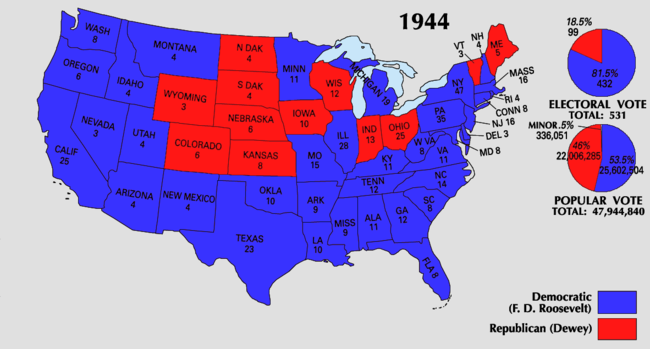

Results by county, shaded according to winning candidate's percentage of the vote
Gallery of maps
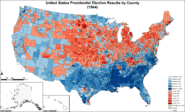
Presidential election results by county
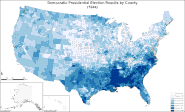
Democratic presidential election results by county

Republican presidential election results by county

"Other" presidential election results by county
Results by state
[11]
| States won by Roosevelt/Truman |
| States won by Dewey/Bricker |
| Franklin D. Roosevelt Democratic | Thomas E. Dewey Republican | No Candidate Southern Democrat/ Texas Regulars | Norman Thomas Socialist | Other | Margin | State total | ||||||||||||||
|---|---|---|---|---|---|---|---|---|---|---|---|---|---|---|---|---|---|---|---|---|
| State | electoral votes | # | % | electoral votes | # | % | electoral votes | # | % | electoral votes | # | % | electoral votes | # | % | electoral votes | # | % | # | |
Alabama | 11 | 198,918 | 81.28 | 11 | 44,540 | 18.20 | - | - | - | - | 190 | 0.08 | - | 1,095 | 0.45 | - | 154,378 | 63.08 | 244,743 | AL |
Arizona | 4 | 80,926 | 58.80 | 4 | 56,287 | 40.90 | - | - | - | - | - | - | - | 421 | 0.31 | - | 24,639 | 17.90 | 137,634 | AZ |
Arkansas | 9 | 148,965 | 69.95 | 9 | 63,551 | 29.84 | - | - | - | - | 438 | 0.21 | - | - | - | - | 85,414 | 40.11 | 212,954 | AR |
California | 25 | 1,988,564 | 56.48 | 25 | 1,512,965 | 42.97 | - | - | - | - | 2,515 | 0.07 | - | 16,831 | 0.48 | - | 475,599 | 13.51 | 3,520,875 | CA |
Colorado | 6 | 234,331 | 46.40 | - | 268,731 | 53.21 | 6 | - | - | - | 1,977 | 0.39 | - | - | - | - | -34,400 | -6.81 | 505,039 | CO |
Connecticut | 8 | 435,146 | 52.30 | 8 | 390,527 | 46.94 | - | - | - | - | 5,097 | 0.61 | - | 1,220 | 0.15 | - | 44,619 | 5.36 | 831,990 | CT |
Delaware | 3 | 68,166 | 54.38 | 3 | 56,747 | 45.27 | - | - | - | - | 154 | 0.12 | - | 294 | 0.23 | - | 11,419 | 9.11 | 125,361 | DE |
Florida | 8 | 339,377 | 70.32 | 8 | 143,215 | 29.68 | - | - | - | - | - | - | - | - | - | - | 196,162 | 40.65 | 482,592 | FL |
Georgia | 12 | 268,187 | 81.74 | 12 | 59,880 | 18.25 | - | - | - | - | 6 | 0.00 | - | 36 | 0.01 | - | 208,307 | 63.49 | 328,109 | GA |
Idaho | 4 | 107,399 | 51.55 | 4 | 100,137 | 48.07 | - | - | - | - | 282 | 0.14 | - | 503 | 0.24 | - | 7,262 | 3.49 | 208,321 | ID |
Illinois | 28 | 2,079,479 | 51.52 | 28 | 1,939,314 | 48.05 | - | - | - | - | 180 | 0.00 | - | 17,088 | 0.42 | - | 140,165 | 3.47 | 4,036,061 | IL |
Indiana | 13 | 781,403 | 46.73 | - | 875,891 | 52.38 | 13 | - | - | - | 2,223 | 0.13 | - | 12,574 | 0.75 | - | -94,488 | -5.65 | 1,672,091 | IN |
Iowa | 10 | 499,876 | 47.49 | - | 547,267 | 51.99 | 10 | - | - | - | 1,511 | 0.14 | - | 3,945 | 0.37 | - | -47,391 | -4.50 | 1,052,599 | IA |
Kansas | 8 | 287,458 | 39.18 | - | 442,096 | 60.25 | 8 | - | - | - | 1,613 | 0.22 | - | 2,609 | 0.36 | - | -154,638 | -21.07 | 733,776 | KS |
Kentucky | 11 | 472,589 | 54.45 | 11 | 392,448 | 45.22 | - | - | - | - | 535 | 0.06 | - | 2,349 | 0.27 | - | 80,141 | 9.23 | 867,921 | KY |
Louisiana | 10 | 281,564 | 80.59 | 10 | 67,750 | 19.39 | - | - | - | - | - | - | - | 69 | 0.02 | - | 213,814 | 61.20 | 349,383 | LA |
Maine | 5 | 140,631 | 47.45 | - | 155,434 | 52.44 | 5 | - | - | - | - | - | - | 335 | 0.11 | - | -14,803 | -4.99 | 296,400 | ME |
Maryland | 8 | 315,490 | 51.85 | 8 | 292,949 | 48.15 | - | - | - | - | - | - | - | - | - | - | 22,541 | 3.70 | 608,439 | MD |
Massachusetts | 16 | 1,035,296 | 52.80 | 16 | 921,350 | 46.99 | - | - | - | - | - | - | - | 4,019 | 0.21 | - | 113,946 | 5.81 | 1,960,665 | MA |
Michigan | 19 | 1,106,899 | 50.19 | 19 | 1,084,423 | 49.18 | - | - | - | - | 4,598 | 0.21 | - | 9,303 | 0.42 | - | 22,476 | 1.02 | 2,205,223 | MI |
Minnesota | 11 | 589,864 | 52.41 | 11 | 527,416 | 46.86 | - | - | - | - | 5,073 | 0.45 | - | 3,176 | 0.28 | - | 62,448 | 5.55 | 1,125,529 | MN |
Mississippi | 9 | 168,479 | 93.56 | 9 | 11,601 | 6.44 | - | - | - | - | - | - | - | - | - | - | 156,878 | 87.12 | 180,080 | MS |
Missouri | 15 | 807,804 | 51.37 | 15 | 761,524 | 48.43 | - | - | - | - | 1,751 | 0.11 | - | 1,395 | 0.09 | - | 46,280 | 2.94 | 1,572,474 | MO |
Montana | 4 | 112,556 | 54.28 | 4 | 93,163 | 44.93 | - | - | - | - | 1,296 | 0.63 | - | 340 | 0.16 | - | 19,393 | 9.35 | 207,355 | MT |
Nebraska | 6 | 233,246 | 41.42 | - | 329,880 | 58.58 | 6 | - | - | - | - | - | - | - | - | - | -96,634 | -17.16 | 563,126 | NE |
Nevada | 3 | 29,623 | 54.62 | 3 | 24,611 | 45.38 | - | - | - | - | - | - | - | - | - | - | 5,012 | 9.24 | 54,234 | NV |
New Hampshire | 4 | 119,663 | 52.11 | 4 | 109,916 | 47.87 | - | - | - | - | 46 | 0.02 | - | - | - | - | 9,747 | 4.24 | 229,625 | NH |
New Jersey | 16 | 987,874 | 50.31 | 16 | 961,335 | 48.95 | - | - | - | - | 3,358 | 0.17 | - | 11,194 | 0.57 | - | 26,539 | 1.35 | 1,963,761 | NJ |
New Mexico | 4 | 81,389 | 53.47 | 4 | 70,688 | 46.44 | - | - | - | - | - | - | - | 148 | 0.10 | - | 10,701 | 7.03 | 152,225 | NM |
New York | 47 | 3,304,238 | 52.31 | 47 | 2,987,647 | 47.30 | - | - | - | - | 10,553 | 0.17 | - | 14,352 | 0.23 | - | 316,591 | 5.01 | 6,316,790 | NY |
North Carolina | 14 | 527,399 | 66.71 | 14 | 263,155 | 33.29 | - | - | - | - | - | - | - | - | - | - | 264,244 | 33.43 | 790,554 | NC |
North Dakota | 4 | 100,144 | 45.48 | - | 118,535 | 53.84 | 4 | - | - | - | 943 | 0.43 | - | 549 | 0.25 | - | -18,391 | -8.35 | 220,171 | ND |
Ohio | 25 | 1,570,763 | 49.82 | - | 1,582,293 | 50.18 | 25 | - | - | - | - | - | - | - | - | - | -11,530 | -0.37 | 3,153,056 | OH |
Oklahoma | 10 | 401,549 | 55.57 | 10 | 319,424 | 44.20 | - | - | - | - | - | - | - | 1,663 | 0.23 | - | 82,125 | 11.36 | 722,636 | OK |
Oregon | 6 | 248,635 | 51.78 | 6 | 225,365 | 46.94 | - | - | - | - | 3,785 | 0.79 | - | 2,362 | 0.49 | - | 23,270 | 4.85 | 480,147 | OR |
Pennsylvania | 35 | 1,940,479 | 51.14 | 35 | 1,835,054 | 48.36 | - | - | - | - | 11,721 | 0.31 | - | 7,539 | 0.20 | - | 105,425 | 2.78 | 3,794,793 | PA |
Rhode Island | 4 | 175,356 | 58.59 | 4 | 123,487 | 41.26 | - | - | - | - | - | - | - | 433 | 0.14 | - | 51,869 | 17.33 | 299,276 | RI |
South Carolina | 8 | 90,601 | 87.64 | 8 | 4,610 | 4.46 | - | 7,799 | 7.54 | - | - | - | - | 365 | 0.35 | - | 82,802 | 80.10 | 103,375 | SC |
South Dakota | 4 | 96,711 | 41.67 | - | 135,365 | 58.33 | 4 | - | - | - | - | - | - | - | - | - | -38,654 | -16.66 | 232,076 | SD |
Tennessee | 12 | 308,707 | 60.45 | 12 | 200,311 | 39.22 | - | - | - | - | 792 | 0.16 | - | 882 | 0.17 | - | 108,396 | 21.23 | 510,692 | TN |
Texas | 23 | 821,605 | 71.42 | 23 | 191,425 | 16.64 | - | 135,439 | 11.77 | - | 594 | 0.05 | - | 1,268 | 0.11 | - | 630,180 | 54.78 | 1,150,331 | TX |
Utah | 4 | 150,088 | 60.44 | 4 | 97,891 | 39.42 | - | - | - | - | 340 | 0.14 | - | - | - | - | 52,197 | 21.02 | 248,319 | UT |
Vermont | 3 | 53,820 | 42.93 | - | 71,527 | 57.06 | 3 | - | - | - | - | - | - | 14 | 0.01 | - | -17,707 | -14.12 | 125,361 | VT |
Virginia | 11 | 242,276 | 62.36 | 11 | 145,243 | 37.39 | - | - | - | - | 417 | 0.11 | - | 549 | 0.14 | - | 97,033 | 24.98 | 388,485 | VA |
Washington | 8 | 486,774 | 56.84 | 8 | 361,689 | 42.24 | - | - | - | - | 3,824 | 0.45 | - | 4,041 | 0.47 | - | 125,085 | 14.61 | 856,328 | WA |
West Virginia | 8 | 392,777 | 54.89 | 8 | 322,819 | 45.11 | - | - | - | - | - | - | - | - | - | - | 69,958 | 9.78 | 715,596 | WV |
Wisconsin | 12 | 650,413 | 48.57 | - | 674,532 | 50.37 | 12 | - | - | - | 13,205 | 0.99 | - | 1,002 | 0.07 | - | -24,119 | -1.80 | 1,339,152 | WI |
Wyoming | 3 | 49,419 | 48.77 | - | 51,921 | 51.23 | 3 | - | - | - | - | - | - | - | - | - | -2,502 | -2.47 | 101,340 | WY |
| Totals: | 531 | 25,612,916 | 53.39 | 432 | 22,017,929 | 45.89 | 99 | 143,238 | 0.30 | - | 79,017 | 0.16 | - | 123,963 | 0.26 | - | 3,594,987 | 7.49 | 47,977,063 | US |
Close states
Margin of victory less than 1% (25 electoral votes):
- Ohio, 0.37%
Margin of victory less than 5% (165 electoral votes):
- Michigan, 1.02%
- New Jersey, 1.35%
- Wisconsin, 1.80%
- Wyoming, 2.47%
- Pennsylvania, 2.78%
- Missouri, 2.94%
- Illinois, 3.47%
- Idaho, 3.49%
- Maryland, 3.70%
- New Hampshire, 4.24%
- Iowa, 4.50%
- Oregon, 4.85%
- Maine, 4.99%
Margin of victory between 5% and 10% (138 electoral votes):
New York, 5.01% (tipping point state)- Connecticut, 5.36%
- Minnesota, 5.55%
- Indiana, 5.65%
- Massachusetts, 5.81%
- Colorado, 6.81%
- New Mexico, 7.03%
- North Dakota, 8.35%
- Delaware, 9.11%
- Kentucky, 9.23%
- Nevada, 9.24%
- Montana, 9.35%
- West Virginia, 9.78%
Miscellanea
This section contains a list of miscellaneous information. (January 2017) |
- The passing of the 22nd Amendment of the United States Constitution in 1951 renders this election the only occasion in United States history in which a candidate has been allowed to run for a fourth term as president.
- The 1944 election was the first one where one of the candidates (Dewey) was born in the 20th century.
- 1944 was, until 2016, the most recent election in which both major party candidates hailed from the same state, as Roosevelt and Dewey were from New York. The 2016 presidential election has now taken that honor as both major candidates in that election, Hillary Clinton and Donald Trump, coincidentally, also identified New York as their home state.
- Except Lyndon B. Johnson's landslide reelection in 1964, no post-1944 Democratic candidate has managed to equal or surpass Roosevelt's margin in popular or electoral votes in this election, which was the closest of all his four campaigns.
- The 1944 election was the last election in which any candidate received over ninety percent of the vote in any state (FDR won 94 percent of votes cast in Mississippi). The Democratic candidate did receive more than ninety percent of the vote in The District of Columbia in 2008, 2012 and 2016.
- The 1944 election was the first since Grover Cleveland's re-election in 1892 in which the bellwether state of Ohio backed a losing candidate.
- This was the first election since 1900 when Idaho and Wyoming did not vote the same as each other, and the last to date.
- The 1944 presidential election was the last election in which the Democratic party candidate won every single state that constituted the Confederacy, as well as all 14 states of the South.
- This was the last time that the Democrats won New Hampshire and Oregon until 1964 and the last time that the Democrats won Connecticut, Delaware, Maryland, Michigan, New Jersey, New York and Pennsylvania until 1960.
- 1944 is the last occasion the Democratic Party has carried Cache, Washington and Box Elder Counties in Utah, Indian River, Lake, Sarasota and Manatee Counties in Florida or Augusta and Orange Counties in Virginia.[12]
See also
- President of the United States
- United States House elections, 1944
- United States Senate elections, 1944
- United States home front during World War II
Hell-Bent for Election, an animated Roosevelt campaign film.- Fourth inauguration of Franklin D. Roosevelt
References
^ "Voter Turnout in Presidential Elections". The American Presidency Project. UC Santa Barbara.
^ Alonzo L. Hamby, Man of the People: A Life of Harry S. Truman (1995) ch 17
^ Weintraub, Stanley. Final Victory: FDR's Extraordinary World War II Presidential Campaign, pp. 29-59
ISBN 0306821133
^ Taft, Robert Alphonso and Wunderlin, Clarence E.; The Papers of Robert A. Taft: 1939-1944, p. 397
ISBN 0873386795
^ Jordan, David M.; FDR, Dewey, and the Election of 1944, pp. 119
ISBN 0253356830
^ Nash, Gerald D.; Franklin Delano Roosevelt, p. 66
ISBN 0133305147
^ Weintraub; Final Victory, pp. 144-149
ISBN 0306821133
^ Jordan; FDR, Dewey and the Election of 1944, p. 266
^ Jordan; FDR, Dewey and the Election of 1944; pp. 111, 214
^ Cunningham, Sean; Cowboy Conservatism and the Rise of the Modern Right; p. 26
ISBN 081317371X
^ "1944 Presidential General Election Data - National". Retrieved April 14, 2013.
^ Sullivan, Robert David; ‘How the Red and Blue Map Evolved Over the Past Century’; America Magazine in The National Catholic Review; June 29, 2016
Further reading
Cantril, Hadley and Mildred Strunk, eds.; Public Opinion, 1935–1946 (1951), massive compilation of many public opinion polls from USA- Gallup, George Horace, ed. The Gallup Poll; Public Opinion, 1935–1971 3 vol (1972) esp vol 1; summarizes results of each poll as reported to newspapers
Hamby, Alonzo L. Man of the People: A Life of Harry S. Truman (1995) ch 17- Savage, Sean J. "The 1936-1944 Campaigns," in William D. Pederson, ed. A Companion to Franklin D. Roosevelt (2011) pp 96–113 online
Smith, Richard Norton. Thomas E. Dewey and His Times (1984), the standard scholarly biography
External links
United States presidential election of 1944 at Encyclopædia Britannica
- Tuesday In November: The 1944 Presidential Election
- 1944 popular vote by counties
How close was the 1944 election? — Michael Sheppard, Massachusetts Institute of Technology- Election of 1944 in Counting the Votes











